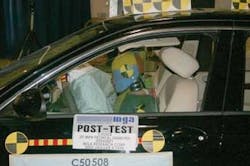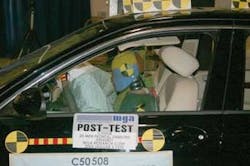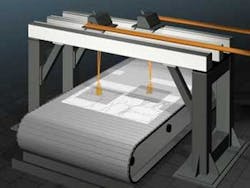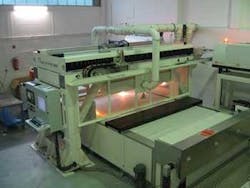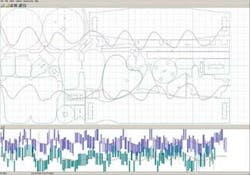Remote laser web cutting
On-the-fly laser cutting systems offer alternatives to traditional punching and mechanical cutting
Annett Klotzbach and Achim Zinke
Flexible and cost-efficient processes are required for the cutting of textile webs, polymer films, or material compounds. A trend today finds mechanical die cutting being replaced by laser cutting, the so-called digital die cutting.
Numerous advantages become obvious when laser cutting systems are compared to tool-based die cutting systems, most of which derive from the tool-free nature of the laser cutters. Because there are no tools, there are no costs for tools or production delays for tool manufacturing. Also, tool-based mechanical cutting systems are characterized by intrinsic limitations, which result from the physical contact between the cutting edge and the material. The ability of tool-free laser cutting systems to reliably handle thin substrates is another benefit. These are the main reasons why laser cutting systems provide a rapid prototyping niche for those who use them.
The melting point of textile webs is lower compared to laser cutting of metals, which leads to lowered requirements for laser beam intensity; thus CW lasers with power in the range of a few hundred watts can be used. However, ongoing development focuses on increasing the cutting speed to produce a shorter cycle time.
In addition to short cycle times, and thus the improvement of process efficiency, the process itself involves a lot of advantages. Because laser cutting is a thermal separation process, the increase in cutting speed leads to the minimization of the heat input in the boundary area of the kerf.
Typical laser cutting machines are gantry systems with XY-axes that physically move lasers, the whole sheet of material, or a combination of both. Because of these structures, the dynamic of the laser spot on the material is limited such that small contours, radii, or geometries must be cut with lower speed or limited accuracy of the beam path.
Several manufacturers have means to overcome these limitations by the use of the following: heavy axes drives in combination with rigid machine construction, lightweight machine construction with fiber-reinforced material components, or multilayer cutting (2–30 layers of the web material are cut simultaneously).
Scientists at Fraunhofer IWS in Dresden identifying the limitations of these solutions have researched whether the well-known galvanometer scanner technology as used in the laser marking industry could be used for laser cutting of textile webs.
New solution: remote technology
The basis to solve the problem of a limited machine dynamic is the use of high dynamic beam deflection, where the laser beam is deflected by fast tilting mirrors and projected on to the material. Due to the low mass of the deflecting mirrors, which are moved by the use of galvanometer scanners, the beam motion is accurate, even at high cutting speeds. Accelerations of multiple 10g are achievable. This rigorous increased dynamic is possible by abandonment of the cutting gas, thus the material in the kerf has to be vaporized completely.
For remote processing, lasers with CW laser radiation are used exclusively, with the laser power reaching multiple kilowatts. The working distance can be up to 2 m, while the scope of action can be 1 m x 1 m. The combination of high laser power and large focal length provides a very high intensity on the material, so cutting speeds of multiple meters per second in textile processing can be implemented.
Efficient production of airbag webs
Today’s automobiles are equipped with a variety of airbags to improve the occupant’s protection and security. It is the variety of these airbags that requires highly flexible and productive system engineering. The cutting of airbag parts (out of up to 3 m wide polyamide webs) is almost exclusively performed by gas assisted laser cutting. Due to the thermal cut, the web edge is melted and not frayed.
During recent years, the efficiency of laser textile cutting has been improved by the development of multilayer systems in which up to 30 material layers can be cut simultaneously. However, the technique is very complex, because a separation of the single layer, which is even sometimes subdivided by interlayers, is absolutely necessary. Furthermore, the cutting quality of the single layer differs, so that the layer quantity has to be reduced, depending on the quality demand.
Because of the disadvantages of multilayer cutting, scientists are looking for new manufacturing solutions like remote laser cutting technology.
The conventional remote system consists of scanning optics and is installed above the material. The spot movement is produced by the use of the scanning mirrors. Because of the complex correlation between working distance, sphere of action, and focus diameter, restrictions result concerning the simultaneously machinable material area.
The concept developed at Held Systems (Heusenstamm, Germany) is to move the web continuously beneath the scanning optics and, thus, to cover the whole material width by oscillating the scanning optics across the web. This technique allows cutting of very wide webs, even with only one scanner and one laser. FIGURE 1 presents a concept schematic, which has been industrialized in cooperation with the IWS. As a result, a new generation of highly compact, flexible, and highly productive airbag laser cutting systems has been developed.
FIGURE 2 shows the Held CONTILAS 2500 2Sc system that consists of the following components: unwind unit with roll changer, material feeder for constant web transport, conveyor for web transport through the cutting area, an enclosed cutting area for laser safety with exhaust system, one or more CO2 slab lasers with 2 kW power, and one or more high-power scanning optics with working area of up to 1 m2.
Single-layer cutting using this machine eliminates the use of separate material (foil, paper) between the web layers and time that employees used to separate the cut packages. Even with single-layer cutting, the production output is from 10 to 100 percent higher with a two-scanner system, depending on the cut outline and the length of the nesting. The machine footprint is reduced to one-third, compared with multi-layer cut systems, for nestings up to 7 m length. The machine is more robust than that of multi-layer systems with exchange desk and exhaust system.
Cutting airbags
The machine concept is characterized by excellent scalability and modularity. Additionally, it is possible to cut One Piece Woven (OPW) material. The production of OPW airbags, a multi-layer technique that allows the pieces to be woven at the same time as the fabric, represents the airbag market’s future.
The particular challenge for an OPW cutting machine is the need for automatic compensation of fabric irregularities like shrinkage or distortion. Reference points on the material have to be detected by the use of a camera system, and then the operating software analyzes the measured positions and recalculates the laser path depending on the actual material characteristics.
Motion planning tools for offline process optimization
The combination of axes systems with different dynamic and mechanical characteristics requires an intelligent movement splitting. Here, the maximum material speed is the main criterion. A suitable splitting of the laser reference path movement to the axis of the scanner head on the one hand and to the NC-main axis on the other hand enables a minimal positioning time between the cutting segments. An offline software system with CAD/CAM functions was especially developed for the CONTILAS technology. It enables the user to independently develop any nestings, and to generate the path programs for the machine (see FIGURE 3). Using graphic interactive menu navigation, the different cut contours are segmented and technology parameters such as cutting speed and laser power are defined. The post optimization routine calculates the chronological order of the cutting jobs, which are manufactured in the machine. This optimization algorithm is successfully used in other machines with redundant axis systems.
Conclusions
The remote “on-the-fly” cutting technique enables cutting to any contour sizes and material widths. By combining the axes systems with different dynamic and mechanical parameters, improvements can be achieved, which makes the laser technique competitive to traditional cutting techniques such as punching or mechanical cutting. This system concept can be transferred to applications in which spatially limited highly dynamic beam deflection is transferred to wide, flat working fields, such as: flexible foil cuts, cutting of leather or paper, welding of heat exchanger plates, and cutting of cover fabric and filler cloth.
Annett Klotzbach ([email protected]) is project leader at the Fraunhofer Institute for Material and Beam Technology Dresden, Germany. Achim Zinke is managing director of Held Systems Deutschland GmbH (www.held-systems.de).
